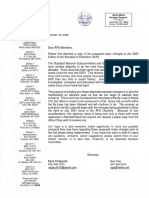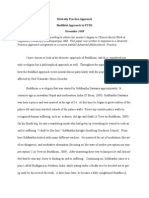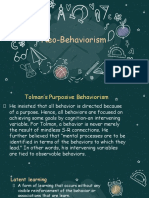14 Principles of Permaculture by Toby Hemenway
14 Principles of Permaculture by Toby Hemenway
Uploaded by
Wen RollandCopyright:
Available Formats
14 Principles of Permaculture by Toby Hemenway
14 Principles of Permaculture by Toby Hemenway
Uploaded by
Wen RollandOriginal Description:
Copyright
Available Formats
Share this document
Did you find this document useful?
Is this content inappropriate?
Copyright:
Available Formats
14 Principles of Permaculture by Toby Hemenway
14 Principles of Permaculture by Toby Hemenway
Uploaded by
Wen RollandCopyright:
Available Formats
14 Principles of Permaculture by Toby Hemenway
1. Observe. Use protracted and thoughtful observation rather than prolonged and thoughtless action. Observe the site and its elements in all seasons. Design for specific sites, clients, and cultures. 2. Connect. Use relative location, that is, place the elements of your design in ways that create useful relationships and time-saving connections among all parts. The number of connections among elements creates a healthy, diverse ecosystem, not the number of elements. 3. Catch and store energy and materials. Identify, collect, and hold useful flows. Every cycle is an opportunity for yield, every gradient (in slope, charge, temperature, and the like) can produce energy. Reinvesting resources builds capacity to capture yet more resources. 4. Each element performs multiple functions. Choose and place each element in a design to perform as many functions as possible. Beneficial connections between diverse components create a stable whole. Stack elements in both space and time. 5. Each function is supported by multiple elements. Use multiple methods to achieve important functions and to create synergies. Redundancy protects when one or more elements fail. 6. Make the least change for the greatest effect. Understand the system you are working with
well enough to find its "leverage points" and intervene there, where the least work accomplishes the most change. 7. Use small-scale, intensive systems. Start at your doorstep with the smallest systems that will do the job and build on your successes. Grow by "chunking"?that is, developing a small system or arrangement that works well?and repeat it, with variations. 8. Optimize edge. The edge?the intersection of two environments? is the most diverse place in a system and is where energy and materials accumulate or are translated. Increase or decrease edge as appropriate. 9. Collaborate with succession. Living systems usually advance from immaturity to maturity, and if we accept this trend and align our designs with it instead of fighting it, we save work and energy. Mature ecosystems are more diverse and productive than young ones. 10. Use biological and renewable resources. Renewable resources (usually living beings and their products) reproduce and build up over time, store energy, assist yield, and interact with other elements. Favor these over nonrenewable resources. Principles Based on Attitudes 11. Turn problems into solutions. Constraints can inspire creative design, and most problems usually carry not just the seeds of their own solution within them but also the inspiration for simultaneously solving other problems. "We are confronted by insurmountable opportunities."?Attributed to Pogo (Walt Kelly). 12. Get a yield. Design for both immediate and long-term returns from your efforts: "You can't work on an empty stomach." Set up positive feedback loops to build the system and repay your investment. 13. The biggest limit to abundance is creativity. The designer's imagination and skill usually limit productivity and diversity before any physical limits are reached. 14. Mistakes are tools for learning. Evaluate your trials. Making mistakes is a sign you're trying to do things better. There is usually little penalty for mistakes if you learn from them.
You might also like
- DSM Oriented Guide For The ASEBADocument45 pagesDSM Oriented Guide For The ASEBACarla Gaspar Duarte100% (1)
- American Poultry Association SOP Proposed ChangesDocument49 pagesAmerican Poultry Association SOP Proposed ChangesCaroline ErstwhileNo ratings yet
- American Agri-Women Respond To FoodIncDocument45 pagesAmerican Agri-Women Respond To FoodIncChandell Sykora Rudeen100% (1)
- Google Webmaster Guidelines 2020Document7 pagesGoogle Webmaster Guidelines 2020V TNo ratings yet
- PR Earth Users Guide EMILY1Document2 pagesPR Earth Users Guide EMILY1Azim AbdoolNo ratings yet
- Healthy - Communities - Handbook PDFDocument50 pagesHealthy - Communities - Handbook PDFgabyilukaNo ratings yet
- Whiffletree - Catalogue-Hardy Fruit Trees 2017Document68 pagesWhiffletree - Catalogue-Hardy Fruit Trees 2017Wen RollandNo ratings yet
- Candy PDFDocument62 pagesCandy PDFAndrei Nicole RiveraNo ratings yet
- Memory Critical Thinking QuestionsDocument2 pagesMemory Critical Thinking QuestionsJun Jun Bay100% (1)
- Creating Accessible Forms in Adobe Acrobat X ProDocument31 pagesCreating Accessible Forms in Adobe Acrobat X ProNISAR_786No ratings yet
- Recycling Architecture: The Redefinition of Recycling Principles in The Context of Sustainable Architectural DesignDocument11 pagesRecycling Architecture: The Redefinition of Recycling Principles in The Context of Sustainable Architectural DesignKris CrystalNo ratings yet
- Creating A Custom HTML Theme - TumblrDocument16 pagesCreating A Custom HTML Theme - TumblrfluidreduxNo ratings yet
- Permaculture Design Playbook - Table of Contents PDFDocument8 pagesPermaculture Design Playbook - Table of Contents PDFakeibo0% (1)
- Development of Embryo ChickDocument14 pagesDevelopment of Embryo ChickSafira Dwi OktavianiNo ratings yet
- The Conceptual Process of 2 Becoming 1 (Repaired)Document6 pagesThe Conceptual Process of 2 Becoming 1 (Repaired)Quame McGodfredNo ratings yet
- Duck RaisingDocument14 pagesDuck RaisingJoraxNo ratings yet
- Chicken Breed ComparisonDocument6 pagesChicken Breed ComparisonAnonymous KAVMawOkAvNo ratings yet
- Urban PermacultureDocument43 pagesUrban Permacultureapi-252298332No ratings yet
- Duck Production: An OverviewDocument14 pagesDuck Production: An OverviewRichard ChurchilNo ratings yet
- ASIL Breeding SystemsDocument2 pagesASIL Breeding SystemsWorrenbuffet RangNo ratings yet
- Checklist For Mobile Food Vehicle Vendor License ApplicationDocument3 pagesChecklist For Mobile Food Vehicle Vendor License ApplicationyousefNo ratings yet
- Personal Introduction: Name: Anjum Nisar Qureshi EducationDocument24 pagesPersonal Introduction: Name: Anjum Nisar Qureshi EducationAmmar QaziNo ratings yet
- Chicken OathDocument16 pagesChicken OathInocencio TiburcioNo ratings yet
- Secrets To Build A Chicken Coop Cheap and EasyDocument2 pagesSecrets To Build A Chicken Coop Cheap and EasyVikram ShrivastavNo ratings yet
- Genetic Resources For Family Poultry Production in IndiaDocument10 pagesGenetic Resources For Family Poultry Production in IndiaLaura Brown100% (1)
- GI For Local Government PDFDocument42 pagesGI For Local Government PDFTri WahyuningsihNo ratings yet
- Going Google ClassroomDocument32 pagesGoing Google ClassroomJim Tuscano100% (5)
- Water Diversion ManualDocument4 pagesWater Diversion ManualPaulNo ratings yet
- Big 6 and Information Literacy StandardsDocument4 pagesBig 6 and Information Literacy StandardsMichael Brocato100% (2)
- 2017 Poultrybeyond2023 Prelim ProgrammeDocument19 pages2017 Poultrybeyond2023 Prelim ProgrammeUday PatelNo ratings yet
- National Statistics Domestic Violence NcadvDocument2 pagesNational Statistics Domestic Violence Ncadvapi-353949122100% (1)
- Introduction To Google ClassroomDocument18 pagesIntroduction To Google ClassroomVidya Sisale100% (3)
- Aquaculture NotesDocument18 pagesAquaculture Notesjmntysol0% (1)
- Duck Rearing MethodsDocument10 pagesDuck Rearing MethodspunyasNo ratings yet
- ESD PermacultureDocument14 pagesESD PermacultureAndrew Rodda100% (5)
- Local Food Project PermacultureDocument16 pagesLocal Food Project PermacultureramaxxNo ratings yet
- PTSD Checklist Civilian VersionDocument2 pagesPTSD Checklist Civilian VersionVVlynnNo ratings yet
- Animal Breeding PolicyDocument7 pagesAnimal Breeding PolicyCosmicHero100% (1)
- AARP Home Fit GuideDocument28 pagesAARP Home Fit GuideCarlos Martin0% (1)
- Buddhist Approach To PTSD - Diversity Practice ApproachDocument9 pagesBuddhist Approach To PTSD - Diversity Practice ApproachicemanNo ratings yet
- Beekeeping Regional Situational-AnalysisDocument115 pagesBeekeeping Regional Situational-Analysissid101rajNo ratings yet
- PTSD Screening ToolDocument1 pagePTSD Screening Toolsavvy_as_98100% (1)
- Online Learning Planner by SlidesgoDocument63 pagesOnline Learning Planner by SlidesgoLala FadhilaNo ratings yet
- School Bus Manufacturing ProcessDocument8 pagesSchool Bus Manufacturing ProcessAshish GuptaNo ratings yet
- Breeder Farm SequenceDocument2 pagesBreeder Farm SequencePat PatNo ratings yet
- Factors Affecting Egg QualityDocument28 pagesFactors Affecting Egg Qualityyenny theresia100% (1)
- Urban Permaculture Design Certification Course - Winter-Spring 2016Document7 pagesUrban Permaculture Design Certification Course - Winter-Spring 2016Steve Mann100% (2)
- Hendersons Chicken ChartDocument28 pagesHendersons Chicken ChartHappy DealNo ratings yet
- Human Issues in Horticulture - A Bibliography PDFDocument160 pagesHuman Issues in Horticulture - A Bibliography PDFvanguardNo ratings yet
- Principles of Social PermacultureDocument2 pagesPrinciples of Social PermacultureParth J DaveNo ratings yet
- Firewood Processor Design Considerations White Paper 1-13-10Document5 pagesFirewood Processor Design Considerations White Paper 1-13-10Magnus Kalling100% (1)
- The Mobile HomeDocument34 pagesThe Mobile HomeHamza BarkallahNo ratings yet
- Sex Determination of Chicks Through Egg CharacteristicsDocument12 pagesSex Determination of Chicks Through Egg CharacteristicsJasher DariaganNo ratings yet
- Social Media Checklist: DailyDocument1 pageSocial Media Checklist: DailySaurabh singhNo ratings yet
- Planner Made Easy1Document4 pagesPlanner Made Easy1api-16307116100% (1)
- Google Sites ManualDocument16 pagesGoogle Sites Manualtaufikspdmsi@gmail.com100% (1)
- Ethics and Principles of PermacutlrueDocument1 pageEthics and Principles of PermacutlrueAmmon FelixNo ratings yet
- Handbook.2Document134 pagesHandbook.2Guillem deuNo ratings yet
- BM PC Principles SummaryDocument2 pagesBM PC Principles SummaryTreeYo PermacultureNo ratings yet
- Per Ma Culture Principles by David HolmgrenDocument4 pagesPer Ma Culture Principles by David HolmgrenTotusha ShazNo ratings yet
- Simple Steps to Sustainability: A Workbook to Guide Individual Climate ActionFrom EverandSimple Steps to Sustainability: A Workbook to Guide Individual Climate ActionNo ratings yet
- Living in Harmony: The Complete Guide to Permaculture and Sustainable LivingFrom EverandLiving in Harmony: The Complete Guide to Permaculture and Sustainable LivingNo ratings yet
- Fruit Tree Guilds in The Edible Forest Garden LandscapeDocument4 pagesFruit Tree Guilds in The Edible Forest Garden LandscapeWen RollandNo ratings yet
- Savio Fruitiers R.N. Déc. 2018Document4 pagesSavio Fruitiers R.N. Déc. 2018Wen RollandNo ratings yet
- The Key Principles and Practicalities of Earthworks - Bristol 21 06Document40 pagesThe Key Principles and Practicalities of Earthworks - Bristol 21 06Wen RollandNo ratings yet
- Whiffletree - Catalogue-Hardy Fruit Trees-Automne 2018Document74 pagesWhiffletree - Catalogue-Hardy Fruit Trees-Automne 2018Wen RollandNo ratings yet
- Rac Emergency Coordinator's ManualDocument89 pagesRac Emergency Coordinator's ManualWen RollandNo ratings yet
- Leafu PDFDocument362 pagesLeafu PDFWen RollandNo ratings yet
- Dave Jacke-Ecological Culture Design-RevisedDocument6 pagesDave Jacke-Ecological Culture Design-RevisedWen Rolland100% (1)
- DIY Solar Still Plan PDFDocument1 pageDIY Solar Still Plan PDFSignora LofaroNo ratings yet
- Air-Layering. Etiolation, Grafting Methods, Scion CompatabilityDocument92 pagesAir-Layering. Etiolation, Grafting Methods, Scion CompatabilityWen RollandNo ratings yet
- Biotic Fertilizers-The Sustainable Topsoil RevolutionDocument24 pagesBiotic Fertilizers-The Sustainable Topsoil RevolutionWen RollandNo ratings yet
- AcresUSA-Compost Tea-Just What The Doctor OrderedDocument3 pagesAcresUSA-Compost Tea-Just What The Doctor OrderedWen RollandNo ratings yet
- Berkeley Method of CompostingDocument3 pagesBerkeley Method of CompostingWen RollandNo ratings yet
- 10 Permaculture Principles-IDEPDocument2 pages10 Permaculture Principles-IDEPWen Rolland100% (4)
- Science: Hoop House Construction For New MexicoDocument10 pagesScience: Hoop House Construction For New MexicoWen RollandNo ratings yet
- PsychologyDocument37 pagesPsychologyraznumr101No ratings yet
- TrucksDocument4 pagesTrucksmonsonjt.usNo ratings yet
- How To Write Concept Papers?Document3 pagesHow To Write Concept Papers?Chrisha DangilanNo ratings yet
- 11 Block DiagramsDocument30 pages11 Block DiagramsKifayat Ullah100% (1)
- Motivation QUIZDocument3 pagesMotivation QUIZjennyNo ratings yet
- Putting Critical Language Pedagogy Into PracticeDocument137 pagesPutting Critical Language Pedagogy Into PracticeHouria Rouabah100% (2)
- GRAMMAR - Embedded QuestionsDocument5 pagesGRAMMAR - Embedded QuestionsCristian Ochoa LimachiNo ratings yet
- A Comparison Between Piaget and Vygotsky Work 2Document1 pageA Comparison Between Piaget and Vygotsky Work 2Gowri NagamahNo ratings yet
- Psychoanalyst GlossaryDocument8 pagesPsychoanalyst GlossaryTamanna TabassumNo ratings yet
- Math Unit Formal Observation 2Document3 pagesMath Unit Formal Observation 2api-249238099No ratings yet
- 11th Grade English & Composition With American Literature, Block ScheduleDocument92 pages11th Grade English & Composition With American Literature, Block Schedulemrscaldwell0No ratings yet
- Social Skills For Adults With ADDDocument6 pagesSocial Skills For Adults With ADDnatpray78No ratings yet
- Part A - Verbal Ability PDFDocument72 pagesPart A - Verbal Ability PDFSaurav kumarNo ratings yet
- Creativity NudgesDocument31 pagesCreativity Nudgesdhanesh15100% (1)
- Test Item AnalysisDocument29 pagesTest Item Analysistutoralexis5No ratings yet
- The Collective UnconsciousDocument4 pagesThe Collective UnconsciousAnna Maria BodurNo ratings yet
- Arooba Kanwal Assignment1Document4 pagesArooba Kanwal Assignment1Shehar BanoNo ratings yet
- MS1 Seq 1 (2G) (Full) PDFDocument17 pagesMS1 Seq 1 (2G) (Full) PDFوردة الصباحNo ratings yet
- Culture Based Strategies in Teaching Araling Panlipunan and The Learning Outcomes of Grade 7 Students in Public SchoolDocument4 pagesCulture Based Strategies in Teaching Araling Panlipunan and The Learning Outcomes of Grade 7 Students in Public SchoolAndrea Hana Deveza100% (1)
- Caldwell 1980Document10 pagesCaldwell 1980jnn drewjnNo ratings yet
- ALGEBRAIC EXPRESSIONS Term 2 Lesson 7 Grade 8Document5 pagesALGEBRAIC EXPRESSIONS Term 2 Lesson 7 Grade 8ssdavieNo ratings yet
- Chapter 2 - EQUIVALENCE AT WORD LEVELDocument37 pagesChapter 2 - EQUIVALENCE AT WORD LEVELLê Anh Vũ100% (2)
- Van Dijk (1997a) Mentions That Discourse Is Usually Identified As A Form of Spoken Language, What Is SaidDocument2 pagesVan Dijk (1997a) Mentions That Discourse Is Usually Identified As A Form of Spoken Language, What Is Saiddina imaniaNo ratings yet
- Prefix / Suffix ReviewDocument1 pagePrefix / Suffix Reviewleigh_marcischakNo ratings yet
- DLP 6Document4 pagesDLP 6jaymarNo ratings yet
- Present Simple vs. Present Continuous Nouns&Adjectives Machu Picchu 1.4, 2.1, 3.1, 4.3Document4 pagesPresent Simple vs. Present Continuous Nouns&Adjectives Machu Picchu 1.4, 2.1, 3.1, 4.3Anonymous rQfQJrZRNo ratings yet
- Lesson 4 - Neo-BehaviorismDocument13 pagesLesson 4 - Neo-BehaviorismRachelle Ann Casera TimoganNo ratings yet
- CounsellingDocument4 pagesCounsellingBhavna SinghalNo ratings yet
- ReduplicationDocument21 pagesReduplicationBrinzei Lucian100% (1)








































































































